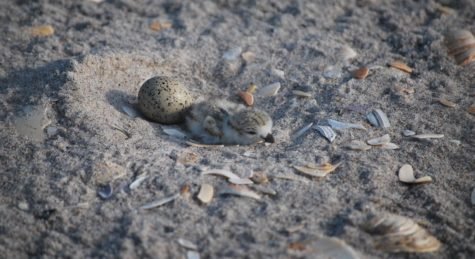By Jillian Liner (Director of Bird Conservation, Audubon New York)
During the summer beach season coastal areas are magnets for birds and people. As we head to the beach to recreate with friends and family, birds are also on the beach working hard to raise their families. Unfortunately, coastal development and recreational uses are compromising vital habitat that birds and other wildlife require to survive and breed successfully. But recreational use and good bird habitat do not need to be at odds. By taking some simple steps people and wildlife can share the shore and derive mutual benefits from Long Island’s beautiful coasts.
Long Island’s ecosystem is one of the richest veins of biodiversity on the planet and is essential to the survival of shorebirds along the Atlantic Flyway. Thousands of at-risk species, including Piping Plovers, American Oystercatchers, Roseate Tern, and Least Terns depend on our shoreline to nest, rest, feed, and raise young. What may seem like everyday use of beaches to us can disturb breeding shorebirds, leaving their eggs or chicks vulnerable to the elements and predators.

The presence of birds like the Piping Plover on our coasts is an indication of a healthy, functioning system – something we should all feel proud of. We can enjoy the beach and simultaneously respect the birds and other wildlife that depend on it. Here are some ways that you can help:
Share the Shore: When visiting the beach, be on the lookout for nesting birds and their chicks and give them plenty of room to feel safe. Do not enter posted or fenced nesting areas, obey local pet laws and keep dogs off of nesting beaches, pick up your trash and do not feed wildlife, and respect off-road vehicle closures. Also, volunteer with us to help others learn about the threats beach-nesting birds face and what steps we can all take to keep them safe.
Stay informed: Learn more about the needs of beach nesting birds and management efforts to protect them. There are a number of misconceptions about beach restrictions – why they are in place, and how long they last. Although restrictions on beaches can be an inconvenience, they only limit some activities and typically do not last all summer. In fact, at some places across the northeast where bird populations have increased to healthy numbers, restrictions have been relaxed throughout the summer. We can get there in New York too.
Be involved: By protecting birds, we’re also safeguarding New York’s great natural heritage for future generations, preserving our shared quality of life, and fostering a healthier environment for us all. Follow Audubon New York for updates on social media and spread the word on how to recognize and help protect nesting sites. To go a step further, take the “Be A Good Egg” pledge found on our website: www.ny.audubon.org/BGE.
By working together we can provide critical, dependable space for shorebirds to raise their families and for migrating birds to rest and refuel so they can successfully complete their long migrations each spring and fall. When birds thrive, people and their communities prosper.
This article was originally published under the title “OP-ED: Audubon NY” on page 38 in the print edition Fire Island News on July 7, 2017.




























